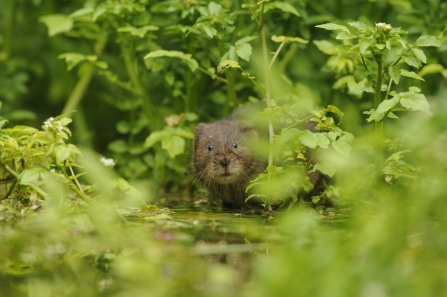The Lagoon was created to protect nearby Long Eaton from flooding by taking water from the Golden Brook when levels are high. Its main purpose is as a flood mitigation area for the Environment Agency, but the reserve is a diverse wetland habitat as well, and is a great example of how natural habitats can help protect against flooding.
Work starts on 10th September at Golden Brook Storage Lagoon Nature Reserve
Golden Brook Storage Lagoon, Derbyshire Wildlife Trust
Gadwell by Richard Steel 2020VISION
Successional processes at Golden Brook, (and other wetland habitats), result in the shrinkage of open water, as the marginal vegetation dies and decomposes. In turn, open water becomes shallower, allowing for the encroachment of vegetation such as greater reedmace (Typha latifolia) and willow scrub. The cycle of expansion and decomposition will eventually lead to the drying out of these open water areas and the development of a habitat dominated by scrub and trees, (although this can be important in its own right).However, it will reduce the capacity of the lagoon to store floodwaters. Management of typha through pulling slows this process, but periodical mechanical dredging of these areas restores the open water habitats to their desired area and depth. The Golden Brook lagoon is currently experiencing a loss of open water features, and therefore work is being undertaken to restore them.
Reed mace by Terry Whittaker/2020VISION
"We have developed a programme of works with the Environment Agency, following site visits, site surveys (including for water voles) and hydrological assessments."
We will be de-silting seven pools and a network of ditches, and removing the vegetation that is filling Golden Brook, which is reducing its flood management capacity. All of work on the reserve will be carried out by the Environment Agency.
Teal by David Tipling-2020VISION
Where large machinery passes over the reserve it can scour the ground, removing the surface layer of vegetation. Having machinery on site may look damaging, the work carried out has numerous benefits alongside the primary reasons for the proposed work. The bare ground created allows for less competitive species to colonise these areas, and with the correct future management these areas can then be preserved. Once completed the restored areas will increase the storage capacity for floodwater, provide resting places for migratory waders and waterfowl, and protection for resident species.

Water vole, Terry Whittaker 2020 Vision
The plan is to start work on 10th September and it should last for 5 weeks. However, this may change depending on site conditions.
For safety reasons, we will have to close the reserve for the duration of the work, although we are planning to arrange dates to see the work in progress safely.
